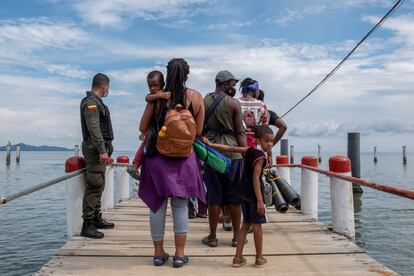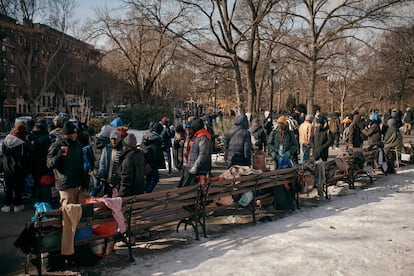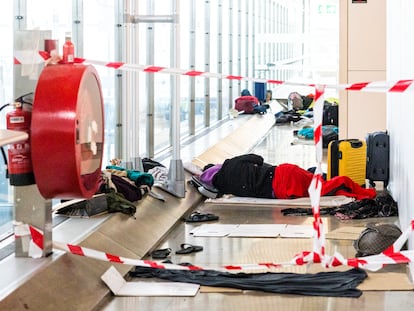NYPD liaison to be posted to Bogotá amid migration crisis
The Colombian capital will become the first city in Latin America to have a permanent envoy from the largest police department in the U.S.

Colombia will strengthen police cooperation ties with the United States by hosting the first liaison post of the New York City Police Department (NYPD) in Latin America, which will soon be established in Bogotá. The representative of the largest municipal police force in the U.S. will join those of 13 other cities, such as Toronto, Tel Aviv, and Madrid. Colombian and New York City authorities are defining details of the memorandum of understanding that will clear the way for the arrival of a high-ranking intelligence officer to provide a permanent presence in the Colombian capital.
While waiting for the details of the agreement to be made public, New York’s deputy commissioner for intelligence and counterterrorism, Rebecca Weiner, discussed the reasons for the decision. “This is borne out of the recognition that we have a lot of vexing problems on our southern border — fentanyl scourge, transnational criminal organizations that might have a footprint into the U.S. and increasingly toward our city, and the migrant crisis,” Weiner said during the annual breakfast of the New York City Police Foundation, according to statements published by the New York Daily News.
The measure involves having an officer in Bogotá to communicate the movements or activities of organized crime structures to New York. Weiner emphasized that the objective is to obtain accurate information as quickly as possible if an event occurs that could affect the most populated city in the United States, and cited as an example the reports of the detective assigned to Tel Aviv on the Hamas attacks in Israel last October. NYPD Commissioner Edward Caban has assured that the liaison post in Bogotá, along with another in Tucson (Arizona), will maximize the department’s regional presence and “provide crucial intelligence that will be vital to the protection of New York City.”
With the support of the @nycpolicefdtn, our two new liaison posts in Tucson, AZ, and Bogota, Colombia, will help the NYPD address the myriad issues that are coming across our southern border.
— Edward A. Caban (@NYPDPC) January 31, 2024
These posts will maximize our regional presence and provide crucial intelligence that… pic.twitter.com/DyJaiIhYo9
The destination city for the liaison — whose identity, as well as the specific location from which he or she will be dispatched, is unknown — was outlined by New York Mayor Eric Adams during his visit to Colombia in October 2023 as part of a tour of Latin America to learn about the main migrant routes to the United States, according to the director general of the Colombian National Police, William Salamanca. “We held meetings with his team, in support and company of Ambassador [Luis Gilberto] Murillo and Ambassador [Francisco] Palmieri, and he raised the possibility of having a liaison officer here,” the general indicated. Salamanca maintains close diplomatic relations with the United States, where he was consul in Miami before assuming his current post at the request of Colombian President Gustavo Petro.
During his visit last year, Mayor Adams witnessed the complexity of the migration phenomenon in Necoclí, a municipality of some 45,000 inhabitants nestled in Antioquia’s Urabá region, where the perilous journey to the Darién Gap begins. He also flew over the jungle between Colombia and Panama, where thousands of people risk their lives trying to reach Central America to make their way north in search of better opportunities. Many of these migrants end up arriving in New York City.
The Colombian Embassy in the United States acknowledged that the visit of delegations from both countries to Necoclí was a key step in understanding the situation at the border crossing and working on joint solutions. “This bilateral collaboration focuses on knowledge sharing, operational advances and improvements in the technical capacity of the Colombian Police to address regional and global challenges, including human mobility,” the embassy confirmed to EL PAÍS.

According to figures from the Ombudsman’s Office, around 520,000 migrants crossed the Darién last year, more than double the number in 2022. The majority were of Venezuelan nationality (328,650), in addition to Ecuadorians, Haitians, Chinese citizens and Colombians. Of the total, 113,180 were children and teenagers. On the Colombian side, the area remains under the control of the Gulf Clan, considered the largest drug trafficking syndicate in the country. The Colombian army estimates that this armed criminal group is paid an average of $125 for each person who tries to cross between the rivers and mountains.
Juan Pappier, deputy director of the Americas Division of Human Rights Watch, explains that the Darién Gap has become a migratory crossroads, one of the facts that explains the appointment of the New York liaison. “The main weaknesses of Latin America in responding to migration converge there: the lack of legal and safe ways to migrate north, the limitations of integration and regularization policies in South America, and the lack of territorial control to protect the population in vast areas of the region,” he says.
The continued arrival of migrants in New York has proved a headache for city authorities. Mayor Adams warned late last year that they had reached “the limit of their capacity” after receiving more than 122,000 asylum applications in less than two years.

The Colombian police have a long history of international cooperation with intelligence agencies around the world in the fight against transnational organized crime, mainly with the United States. Former defense minister and former ambassador Gabriel Silva Luján emphasizes that the alliance with the NYPD is based on the shared need to counteract irregular migration.
“Undoubtedly what has happened with illegal migration is that Colombia has become the most important transit country in the region where people arrive from everywhere — Africa, Asia, Latin America and the Caribbean — to try to get to the United States. If one wants to understand the phenomenon and gather relevant intelligence to prevent situations in New York and its area of influence, it makes sense that the police want to have that presence,” Silva said.
Once the memorandum of understanding is formalized, the scope of cooperation will be defined. For Colombia, it could mean access to information that will help dismantle criminal organizations. “The New York area is one of the most relevant destination zones for many of the illegal migrants trafficked by Colombian mafias, including the Gulf Clan. Any information that helps to uncover how these gangs operate will be very welcome. Additionally, the NYPD has capabilities that the Colombian police does not have,” added the former minister.
Mathew Charles, a sociologist and researcher at the Externado University of Colombia on organized crime issues, believes that having an alliance at the city level will guarantee more direct access to information on both sides of the border. “This is important because those who investigate are often the local police. If they talk to each other, it can improve their investigations and capabilities to deal with transnational crime.”
The New York City Police Foundation, an independent non-profit organization founded to contribute to improving public safety, will cover the expenses for the liaisons in Bogotá and Tucson, while their salaries will be assumed directly by the police institution to which they belong. “Our philosophy always has been, it’s the undergirding of our liaison program — we’re not going to wait for the problems to come to us,” said Weiner.
Sign up for our weekly newsletter to get more English-language news coverage from EL PAÍS USA Edition
Tu suscripción se está usando en otro dispositivo
¿Quieres añadir otro usuario a tu suscripción?
Si continúas leyendo en este dispositivo, no se podrá leer en el otro.
FlechaTu suscripción se está usando en otro dispositivo y solo puedes acceder a EL PAÍS desde un dispositivo a la vez.
Si quieres compartir tu cuenta, cambia tu suscripción a la modalidad Premium, así podrás añadir otro usuario. Cada uno accederá con su propia cuenta de email, lo que os permitirá personalizar vuestra experiencia en EL PAÍS.
¿Tienes una suscripción de empresa? Accede aquí para contratar más cuentas.
En el caso de no saber quién está usando tu cuenta, te recomendamos cambiar tu contraseña aquí.
Si decides continuar compartiendo tu cuenta, este mensaje se mostrará en tu dispositivo y en el de la otra persona que está usando tu cuenta de forma indefinida, afectando a tu experiencia de lectura. Puedes consultar aquí los términos y condiciones de la suscripción digital.
More information
Archived In
Últimas noticias
‘How does it feel to be a failure?’: Elizabeth Berkley’s journey from ‘Showgirls’ ridicule to vindication
The story of the Málaga virus: The code that haunted Google’s cybersecurity center director for 30 years
The impact of Ecuador’s mega-prison: A polluted river, cleared forests and military checkpoints
Corinne Low: ‘I’m more concerned about the female happiness gap than the gender wage gap’
Most viewed
- The low-cost creative revolution: How technology is making art accessible to everyone
- Christian Louboutin: ‘Young people don’t want to be like their parents. And if their parents wear sneakers, they’re going to look for something else’
- All the effects of gentrification in one corner of Mexico’s Colonia Roma
- Liset Menéndez de la Prida, neuroscientist: ‘It’s not normal to constantly seek pleasure; it’s important to be bored, to be calm’
- December Social Security and SSI payments: Dates, double checks and the 2026 COLA increase









































